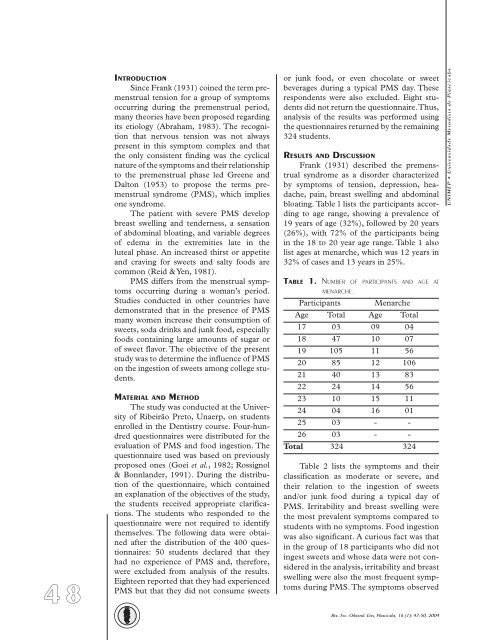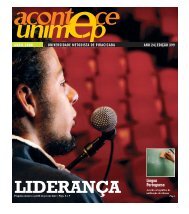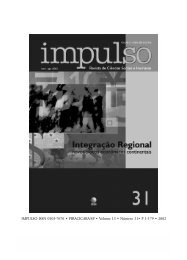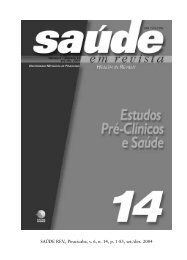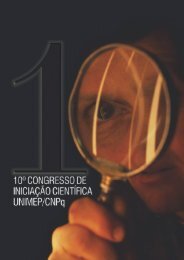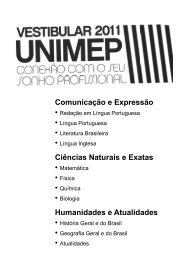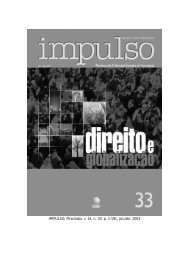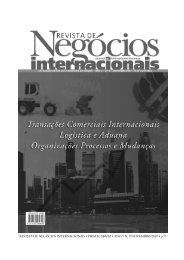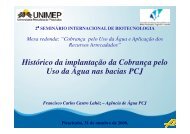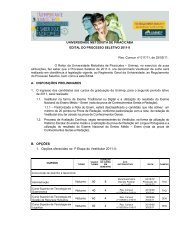002526_RFOL16n1 jor copy.idd - Unimep
002526_RFOL16n1 jor copy.idd - Unimep
002526_RFOL16n1 jor copy.idd - Unimep
Create successful ePaper yourself
Turn your PDF publications into a flip-book with our unique Google optimized e-Paper software.
4 8<br />
INTRODUCTION<br />
Since Frank (1931) coined the term premenstrual<br />
tension for a group of symptoms<br />
occurring during the premenstrual period,<br />
many theories have been proposed regarding<br />
its etiology (Abraham, 1983). The recognition<br />
that nervous tension was not always<br />
present in this symptom complex and that<br />
the only consistent finding was the cyclical<br />
nature of the symptoms and their relationship<br />
to the premenstrual phase led Greene and<br />
Dalton (1953) to propose the terms premenstrual<br />
syndrome (PMS), which implies<br />
one syndrome.<br />
The patient with severe PMS develop<br />
breast swelling and tenderness, a sensation<br />
of abdominal bloating, and variable degrees<br />
of edema in the extremities late in the<br />
luteal phase. An increased thirst or appetite<br />
and craving for sweets and salty foods are<br />
common (Reid & Yen, 1981).<br />
PMS differs from the menstrual symptoms<br />
occurring during a woman’s period.<br />
Studies conducted in other countries have<br />
demonstrated that in the presence of PMS<br />
many women increase their consumption of<br />
sweets, soda drinks and junk food, especially<br />
foods containing large amounts of sugar or<br />
of sweet flavor. The objective of the present<br />
study was to determine the influence of PMS<br />
on the ingestion of sweets among college students.<br />
MATERIAL AND METHOD<br />
The study was conducted at the University<br />
of Ribeirão Preto, Unaerp, on students<br />
enrolled in the Dentistry course. Four-hundred<br />
questionnaires were distributed for the<br />
evaluation of PMS and food ingestion. The<br />
questionnaire used was based on previously<br />
proposed ones (Goei et al., 1982; Rossignol<br />
& Bonnlander, 1991). During the distribution<br />
of the questionnaire, which contained<br />
an explanation of the objectives of the study,<br />
the students received appropriate clarifications.<br />
The students who responded to the<br />
questionnaire were not required to identify<br />
themselves. The following data were obtained<br />
after the distribution of the 400 questionnaires:<br />
50 students declared that they<br />
had no experience of PMS and, therefore,<br />
were excluded from analysis of the results.<br />
Eighteen reported that they had experienced<br />
PMS but that they did not consume sweets<br />
or junk food, or even chocolate or sweet<br />
beverages during a typical PMS day. These<br />
respondents were also excluded. Eight students<br />
did not return the questionnaire. Thus,<br />
analysis of the results was performed using<br />
the questionnaires returned by the remaining<br />
324 students.<br />
RESULTS AND DISCUSSION<br />
Frank (1931) described the premenstrual<br />
syndrome as a disorder characterized<br />
by symptoms of tension, depression, headache,<br />
pain, breast swelling and abdominal<br />
bloating. Table l lists the participants according<br />
to age range, showing a prevalence of<br />
19 years of age (32%), followed by 20 years<br />
(26%), with 72% of the participants being<br />
in the 18 to 20 year age range. Table 1 also<br />
list ages at menarche, which was 12 years in<br />
32% of cases and 13 years in 25%.<br />
TABLE 1. NUMBER OF PARTICIPANTS AND AGE AT<br />
MENARCHE.<br />
Participants<br />
Menarche<br />
Age Total Age Total<br />
17 03 09 04<br />
18 47 10 07<br />
19 105 11 56<br />
20 85 12 106<br />
21 40 13 83<br />
22 24 14 56<br />
23 10 15 11<br />
24 04 16 01<br />
25 03 - -<br />
26 03 - -<br />
Total 324 324<br />
Table 2 lists the symptoms and their<br />
classification as moderate or severe, and<br />
their relation to the ingestion of sweets<br />
and/or junk food during a typical day of<br />
PMS. Irritability and breast swelling were<br />
the most prevalent symptoms compared to<br />
students with no symptoms. Food ingestion<br />
was also significant. A curious fact was that<br />
in the group of 18 participants who did not<br />
ingest sweets and whose data were not considered<br />
in the analysis, irritability and breast<br />
swelling were also the most frequent symptoms<br />
during PMS. The symptoms observed<br />
Rev. Fac. Odontol. Lins, Piracicaba, 16 (1): 47-50, 2004<br />
UNIMEP • Universidade Metodista de Piracicaba


